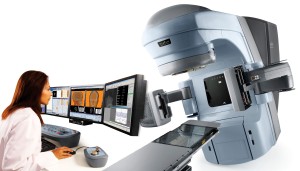 Isn’t it a beautiful thing when technology improves, especially in the medical field? Mesothelioma patients who received novel radiation therapy followed by lung-sparing pleurectomy/decortication (P/D) surgery lived almost twice as long as those who underwent the more aggressive extrapleural pneumonectomy (EPP) according to a recent study. These results encouraged a trend away from EPP, which used to be considered the best surgical choice because it removes more of the cancer.
Isn’t it a beautiful thing when technology improves, especially in the medical field? Mesothelioma patients who received novel radiation therapy followed by lung-sparing pleurectomy/decortication (P/D) surgery lived almost twice as long as those who underwent the more aggressive extrapleural pneumonectomy (EPP) according to a recent study. These results encouraged a trend away from EPP, which used to be considered the best surgical choice because it removes more of the cancer.
But new radiation techniques suchs as the Intensity Modulated Radiation Therapy (IMRT) is starting to improve the quality of radiation with more precise and higher doses to targeted areas. The aim is to shift toward less aggressive surgery. “The goal is to kill the disease and allow patients to still have high-quality lives, says Daniel Gomez, M.D., assistant professor in the Radiation Oncology Department at MD Anderson Cancer Center in Texas
Researchers at MD Anderson and Princeton Radiation Oncology cancer treatment center conducted a study: 24 patients with mesothelioma received the P/D and IMRT combination from 2009 to 2013. These patients were then compared with 24 mesothelioma patients (same age, nodal status, performance status) who underwent the EPP-IMRT combination from 2001 to 2011 (from a previous study).
The EPP surgery completely removes the diseased lung, the lining of the chest, heart, and parts of the diaphragm. The P/D procedure removes the lining around the lung and then carefully removes any more tumor masses on the lung or other parts of the chest.
While both procedures are still performed for mesothelioma patients, there has been much debate over which is more effective. This study’s findings include that the median overall survival was 28.4 months for the P/D group while the EPP groups findings were 14.2 months. The progression free survival was 16.4 months for P/D and 8.2 months for EPP patients. At the one-year mark, the overall survival for P/D patients was 76% and for EPP patients it was 55%. Also at the one-year mark, progression free survival for P/D patients was 67% and for EPP patients it was 55%.
There was one downside to the IMRT that made the P/D more effective. It produced little high-grade toxicity but declined in pulmonary function. “This is not a panacea for treatment,” Gomez says. “The decline in pulmonary function is inevitable because the area being treated.”
Researchers found 19% pulmonary decline from baseline to post-surgery and a 29% decline from baseline to post IMRT.
There have been improvements but we still have more progress to make. “Radiation therapy has come a long way, “ said Gomez. “I think our results showed that this technique after a pleurectomy can be very beneficial.”
